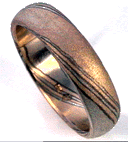
4mm
5mm



Mokume-gane is a mixture of metals with a distinctive layered pattern, literally translating as "wood eye metal". First made in 17th-century Japan, the mixed metal form of mokume-gane was used for katana (sword) fittings until the Meiji era, when the decline of the katana industry forced its artisans to create purely decorative items instead.
The traditional components were relatively soft metallic elements and alloys-- copper, silver, shakudo shibuichi, and kuromido-- which could form eutectic surface bonds with one another without completely melting. After the original metal sheets were stacked and carefully heated, the solid billet of simple stripes could be hammered flat and folded to increase the pattern's complexity.
In addition to providing more force for flattening and folding, the modern hydraulic press can induce solid-state diffusion between the interleaved metals, allowing the inclusion of many others such as titanium, platinum, stainless steel, bronze, brass, nickel silver, and various colors of karat gold. As another recent variation, "mokume-gane" has also been used to describe similarly-patterned laminations among different colors of polymer art clay.